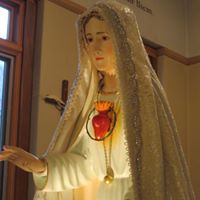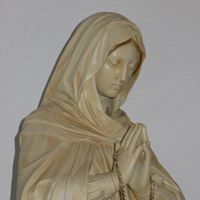

Mary is inextricably a part of God’s plan for the salvation of mankind. She is the Theotokos, the Mother of God, elect daughter of the Father, spouse of the Holy Spirit, and guide of the pilgrim Church. In his encyclical, Redemptoris Mater, Mother of the Redeemer, Pope John Paul II develops the Mariology delineated by the Fathers of Vatican II: “She, like the Church, is both spouse and mother. The Church journeys through time toward the consummation of the ages to meet the Lord who comes. But on this journey… she (the Church) proceeds along the path already trodden by the Virgin Mary, who advanced in her pilgrimage of faith, and loyally persevered in her union with her Son unto the Cross.’ (LG #58)” (RM #1) With Mary’s consent, the promises to Abraham and to David were fulfilled in the incarnation of the Word, who “became flesh and dwelt among us.” (Jn.1:33) Any authentic Marian spirituality recognizes and embraces these Trinitarian, Christological, and Ecclesial dimensions. Likewise, every authentic Marian doctrine comes to life in authentic devotion. At the beginning of Pope John Paul II’s pontificate he dedicated both his being and his mission as pope to Mary. His motto, “Totus Tuus” -“ I am entirely yours!” – was preached in all his weekday audiences, encyclicals, and travels. It was lived every day to the end, even when, close to death and, post-tracheotomy, discovering himself without a voice, he scratched in pen as his response to this sad finale of his pontificate: “What have they done to me?! But…Totus Tuus!“
” Our Theotokos, united with the Church is already the eschatological fulfillment of the Church” (Lumen Gentium, LG#65) Mary has completed the long pilgrimage of faith that began at the annunciation and reached its climax at the foot of the Cross. She is the model of all virtues, the sinless maiden, the Mother of Jesus, the Church, and all humankind. She now looks down upon us with love and tenderness, intercedes for us, and beckons us to follow her Son. In short, she is our Mother. She is our guiding star for our journey through this “vale of tears”. Do we not need this Mother? What is our hearts’ response to her?
We can ignore her. As St. Francis de Sales preached in his homily for the Annunciation, March 25, 1621: “The human heart is a singer infinitely loved by God… But this singer is changeable and more inconstant and fickle than can be expressed… this human heart allows itself to be carried away by its fancies and goes from creature to creature, from house to house, to see if it cannot find someone who will receive it and give it perfect satisfaction. But in vain…” Far from gazing on Mary, the Star of the Sea, we can steer our boat toward our own false or limited loves, freedom, fulfillment, success, wealth, power, or honor – listening to the enchanting music of these mythical Sirens who beckon us to shipwreck on unseen shoals. “Worldly advantages, houses, gold and silver, riches, even honors, dignities, which our ambition makes us seek so madly – are we not foolish to fix our hearts on them?” St. Francis exhorts. “Instead of giving true repose and tranquility, they cause eagerness and great anxiety, to preserve or increase them if we have them, or to acquire them if we do not possess them.” Yet, if we do not go to Mary, as our mother, she is patient and still waits for us with wistful longing.
We can refer to her and defer to her, more or less, like a pocket guide, when and where we choose. At set times and places when the sea is calm, or when storm clouds threaten and the seas get choppy. A rosary, an invocation, a novena. All these devotions and regimens are pleasing to our humble mother, but it is our heart that she most desires.
And yes, we can choose to give her our heart. We can then fix our gaze on her at all times We can hold her hand on this pilgrimage of life, entrusting our very lives to her. This is the devotion that St. Louis de Montfort preached and proposed in his book, True Devotion to Mary. This is the devotion that Pope Saint John Paul II lived and recommended when he entrusted the third millennium to her Immaculate Heart on October 8, 2000, the day after the Feast of the Holy Rosary. On that day, he addressed Mary as he spoke to the bishops gathered in Rome: “You are the splendor which in no way dims the light of Christ, for you exist in him and through him. Everything in you is fiat; you are the Immaculate One, through you there shines the fullness of grace.” For him, the rosary was much more than a recited prayer, it was reliving the mysteries of Jesus’ life with her, pondering them in her maternal heart. For him, Mary was the incomparable model of contemplating Christ – for her gaze never left his, and his never left hers.
Not only in contemplative prayer, but also in imitation of her virtues do we keep our gaze fixed on this shining star. Because she is the model of all virtues, we should see Mary not only as a single, bright guiding star, but as a cluster of stars. As St. Francis de Sales points out, “…her life was nothing else but a continuous passage from virtue to virtue.” (FdS, Sermon, March 25, 1621) And, according to St. Francis in this same homily, the stars of greatest magnitude in this cluster of eminent virtues are the virtues of purity, humility and charity. Her virginity and purity were unsurpassed in all creation because they were chosen and fruitful. Not only did she conceive Our Lord as a virgin, but she has drawn others to her purity – enrolling young virgins to dedicate themselves entirely to God – as well as those who regain their purity – like Mary Magdalen – to become beautiful and pure once more. Her humility is also unmatched, for at the very moment that she is declared the chosen of God by the Angel Gabriel, she declares herself “the slave of the Lord”. She is ever-ready to serve the Lord, forever following the lead of the Holy Spirit. She thus travels to help her pregnant cousin Elizabeth, journeys to Bethlehem at the command of the governor and gives birth to Jesus there, flees to the faraway land of Egypt at a moment’s notice, follows her Son even to the Cross, and acts as mother to the infant Church. Her humility is one of entire obedience, dedication, and faith. Her charity, too, is unequaled for it was proven by the total gift of herself and by the sacrifice of her only Son. She held nothing back and advises us to do the same: “Do whatever he tells you.” (Jn. 2:5)
With Mary, our Mother, as our guiding star, there is safety and assurance. We can fix our gaze on her and entrust our lives to her unfailing and infallible guidance. We can then bring our little boat safely to port – to heaven.
As St. Bernard of Clairvaux once wrote:
She is that magnificent and extraordinary star; so much needed, set in place by necessity above this vast and spacious sea, resplendent with merits; shining with examples for our imitation. Oh, whosoever thou art that perceiveth thyself to be drifting on the river of this age through violent winds and storms, rather than walking on firm ground, turn not away thy eyes from the splendor of this Star, unless thou wish to be submerged by the storms! When the storms of temptation burst upon thee, when thou see thyself driven upon the rocks of tribulation, look at the star, call upon Mary! When buffeted by billows of pride, or ambition, or hatred, or jealousy, look at the star, call upon Mary! Should anger or avarice, or fleshly desire violently assail the frail vessel of they soul, call upon Mary ! If…thou are beginning to sink into the gulf of sadness and to be swallowed in the abyss of despair, then think of Mary! Let her name not leave they lips, let her not leave they Heart.
